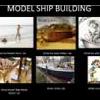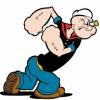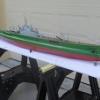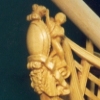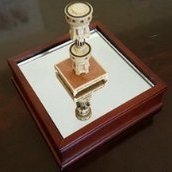-
Posts
722 -
Joined
-
Last visited
Reputation Activity
-
 capnharv2 reacted to xken in Maersk Detroit by xken - 1:354 scale - Container ship
capnharv2 reacted to xken in Maersk Detroit by xken - 1:354 scale - Container ship
The ladders have arrived from Tom's Modelworks. While waiting for them to arrive I made the bollards for the decks and started the winches for the decks. There appears to be three different kinds of winch set-ups; two for anchors, 6 for mooring and two that I will call general purpose. All start out with the same basic construction with add-ons for specific purposes.
After grinding a parting tool down to 1/32" to cut the gaps between the rope reels, I started by turning the basic reel set up starting with 3/16" brass bar and then started one of the frames for sizing. I used a turned piece of aluminum and moved the cutting tool horizontally to cut grooves for fins on the electric motor. 1 started 9 to go as well as finishing up the ladder ways.
My build time and updates will now be sporadic at best until New Years; my son, his wife and the twin grandsons travel tomorrow from NYC and will be here until the 28th. This will be their first time seeing the Constitution completed that will eventually be at their home on Long Island.
-
 capnharv2 got a reaction from Altduck in Constitution by Geoff Matson - Model Shipways 2040 - 1/76 scale
capnharv2 got a reaction from Altduck in Constitution by Geoff Matson - Model Shipways 2040 - 1/76 scale
Michael,
It's under the compass app. When you get the compass, just slide it over and you will see the level.
It's fun to play with.
Hope that helps,
Harvey
-
 capnharv2 reacted to garyshipwright in HMS Montague 1779 by garyshipwright - 74-gun Alfred-class
capnharv2 reacted to garyshipwright in HMS Montague 1779 by garyshipwright - 74-gun Alfred-class
Thanks Grant, Ed and Gaetan, its good to be back. Have missed you guys and seems a lot has gone on since I have been gone. Ed the ship that was in the back ground is the Bonhomme Richard, 1779. Built her in the nintys and was the one I built before starting on Montagu. Believe I finished her right around the time the misses had our daughter, which would make Richard about 19teen years old. My how time fly's when your having fun. Gaetan you are so right and building it got me back out in to the workshop and close to Montagu. Seems she kept calling my name, Gary build me and they will come. Thats my story and am sticking to it. Have added a photo of Richard here for you Ed.
gary
-
 capnharv2 reacted to Dan Vadas in Bismarck by Dan Vadas - FINISHED - GPM - 1:200 - CARD and PE
capnharv2 reacted to Dan Vadas in Bismarck by Dan Vadas - FINISHED - GPM - 1:200 - CARD and PE
Thanks Carl, I'm starting to get the hang of working with PE .
Speaking of PE, I've made the Main Battery Gun Control one. It's only two parts, but no instructions whatsoever of it's construction are in either the kit or the PE sheet. Luckily I have the 3D Bismarck book to fall back on. The PE is a reasonable facsimile :
Painted and fitted. I've finished this sub-assembly as well :
An overview of the forward superstructure up to this point :
Danny
-
 capnharv2 reacted to garyshipwright in HMS Montague 1779 by garyshipwright - 74-gun Alfred-class
capnharv2 reacted to garyshipwright in HMS Montague 1779 by garyshipwright - 74-gun Alfred-class
Hello Every one. I finally went back to work on Montagu after a long break due to work and a few health issues. I was building some plastic models but nothing like building and working on Montagu. Also have done some changes to the work shop and do believe that I finally have the ship yard just the way I like it. Other then a few larger tools and a new drafting board hung from the ceiling not much more to do but get to work on Montagu. I did finally get around to making my hobby bench and not only was it a joy to build but is even more enjoyable to work on. Hope you enjoy the photos of Montagu. Also added a gantry to the building board that was taken from Eds idealy and book. should come in real handy. For the last couple of days I have been working on the port side channel wale. At first I did it in pear but didn't like the color of it against the frames and changed it to boxwood and looks a whole lot better. If you have any question's let me know, and glad to be back. Gary
-
 capnharv2 reacted to Dan Vadas in Bismarck by Dan Vadas - FINISHED - GPM - 1:200 - CARD and PE
capnharv2 reacted to Dan Vadas in Bismarck by Dan Vadas - FINISHED - GPM - 1:200 - CARD and PE
The funnel is finally finished, and I've also finished the two aft searchlights. These are fitted, along with the two 20mm guns I made earlier :
I also decided to add real louvres to the flat printed ones. They have a real sense of depth now . I made them from strips of 1mm wide card :
Danny
-
 capnharv2 reacted to xken in Maersk Detroit by xken - 1:354 scale - Container ship
capnharv2 reacted to xken in Maersk Detroit by xken - 1:354 scale - Container ship
Pictures show both balls a rusted color; I will have to check with Evan. One of the things the ship will have done in dry dock is a complete repaint. I finished up machining all the tiny signal lights, I had to break out my magnification glasses to make them. Here are a couple of images, one with the penny provides a sense of scale.
Now back to work.
-
 capnharv2 reacted to EdT in Young America 1853 by EdT - FINISHED - extreme clipper
capnharv2 reacted to EdT in Young America 1853 by EdT - FINISHED - extreme clipper
Young America - extreme clipper 1853
Part 253 – Wooden Blocks
There are well over 500 blocks on the model, ranging from 15" in shell length down to 4". These include triple, double, and single blocks. Some will be iron strapped, some spliced to pendants, but most will be rope strapped. "Strap" seems to be the American usage for the word "strop" so I will adopt it for this American ship.
Some of these blocks, in a range of sizes, will need to be fitted to the lower fore yard before it is installed. To avoid getting into one-at-a-time, piecemeal work, some mass production was adopted. So the next major task will be to make at least a substantial portion of the full requirement. The few blocks installed so far were leftovers from a previous model.
At the outset of the rigging work a detailed "Rigging List" was developed to describe every line on the model, including its components. From this, a count of blocks of each type of block was tabulated. To that was added an estimate for studding sail blocks. Those lines are not included on the list.
The blocks are being made from my best quality European boxwood – for hardness, strength, and color. Whenever I dip into what I have left of this wood, I immediately get frugal about waste. For the full supply of blocks, I sliced off a wood blank about 2" wide, 8" long, and slightly thicker than the shell breadth of the largest size, 15" blocks. The first picture shows strips sliced from this plank for all the larger blocks – down to 9" singles.
Using the thickness sander, the 2" wide blank was first reduced in thickness to the shell breadth of the 15" blocks. A single strip was then sliced from this at the single block width. There are no 15" doubles or triples. For the next size down, the 12" blocks, the blank was again reduced in thickness. Adequate strips for triple, double and single widths were sliced off that – and so on. This one blank may suffice for all the blocks.
The pictures below show work on the 12" triple blocks. I was surprised at the number of these – about 25 as I recall. Their use in triple-purchase tackles for topsail sheets account for most of these.
To mass produce the blocks to specified dimensions, a table of block dimensions for each size was used to produce a drilling pattern and sequence. This was used to drill correctly spaced holes in each strip, starting with transverse holes at the ends of the shells to delineate length and also to provide a slight top and bottom groove to seat the strapping. This is shown in the next picture.
Before drilling, a shallow groove was scraped along the strip on both outer shell sides. This is a modeling convenience that helps in seating the straps, especially the round copper wire "iron" straps that will be filed flat on the outside. Scrapers for this were made by machine grinding a razor blade for each shell breadth.
The next picture shows the strip rotated in the vise for drilling of the smaller, 1½" (.022") sheave holes – six in each of these triple blocks.
All holes were located using the calculated spacings, set by the mill's calibrated wheels. In the picture, the center row has been drilled and one of the outer rows is in progress. These holes are very close together, so sharp bits, short bit projection, high speed, and very light feed are essential. Even at that, the entry point of the drill in these unmarked holes may vary by a few thousandths as may be seen in the next photo.
Next, slots were pared out between the sheave holes and the sheave curvature cut, using a small chisel as shown in the next picture.
The chisel width was ground to match the drill size and then downsized for each smaller size of block. The next picture shows the strip after this slotting work.
A knife edge file was then used to mark all four faces at the separation points using the first-drilled, transverse holes as guides. The blocks were then given a preliminary rounding with a barrette file while still attached as shown in the next picture.
The next picture shows blocks being cut from the strip using a fine-bladed jewelers saw.
Each block was then rounded to its final shape using a sanding strip. The last picture shows the finished set of 12" blocks, including two with iron strapping and hooks.
The strapping on the two blocks shown will be blackened. The single blocks to the left have not yet been fully rounded.
Ed
-
 capnharv2 got a reaction from PeteB in Young America 1853 by EdT - FINISHED - extreme clipper
capnharv2 got a reaction from PeteB in Young America 1853 by EdT - FINISHED - extreme clipper
Fantastic work Ed-something to aspire to.
Maybe a dumb question, but I'm a little thick headed these days anyway-why are there 4 holes in the block? I understand the 2 for the sheaves and the 1 for attachment, but I don't know what the hole in the middle does-other than to hold the plates together should the block be disassembled for maintenance. Just curious. . .
Thanks again for enlightening us with such beautiful work and clear instructions.
Harvey
-
 capnharv2 got a reaction from popeye the sailor in US Brig Syren by fnkershner - Model Shipways - 1:64
capnharv2 got a reaction from popeye the sailor in US Brig Syren by fnkershner - Model Shipways - 1:64
Flo
After you drill (or punch or whatever you do) the holes for putty, consider putting some type of sealant (like a flat, clear lacquer) in the holes before putting the putty in. That should help keep the stain in the putty from migrating into the end grain of the holly. One nice thing about putting a clear finish in the holes is that you should be able to scrape the deck to get any excess off.
Just a thought.
Hope that helps.
Thanks,
Harvey
-
 capnharv2 got a reaction from Piet in Young America 1853 by EdT - FINISHED - extreme clipper
capnharv2 got a reaction from Piet in Young America 1853 by EdT - FINISHED - extreme clipper
Thanks Ed. That makes sense, since you don't want to it to fly apart when repairing it in a seaway.
Harvey
-
 capnharv2 got a reaction from Piet in Young America 1853 by EdT - FINISHED - extreme clipper
capnharv2 got a reaction from Piet in Young America 1853 by EdT - FINISHED - extreme clipper
Fantastic work Ed-something to aspire to.
Maybe a dumb question, but I'm a little thick headed these days anyway-why are there 4 holes in the block? I understand the 2 for the sheaves and the 1 for attachment, but I don't know what the hole in the middle does-other than to hold the plates together should the block be disassembled for maintenance. Just curious. . .
Thanks again for enlightening us with such beautiful work and clear instructions.
Harvey
-
 capnharv2 got a reaction from EdT in Young America 1853 by EdT - FINISHED - extreme clipper
capnharv2 got a reaction from EdT in Young America 1853 by EdT - FINISHED - extreme clipper
Thanks Ed. That makes sense, since you don't want to it to fly apart when repairing it in a seaway.
Harvey
-
 capnharv2 got a reaction from mtaylor in Young America 1853 by EdT - FINISHED - extreme clipper
capnharv2 got a reaction from mtaylor in Young America 1853 by EdT - FINISHED - extreme clipper
Thanks Ed. That makes sense, since you don't want to it to fly apart when repairing it in a seaway.
Harvey
-
 capnharv2 got a reaction from mtaylor in Young America 1853 by EdT - FINISHED - extreme clipper
capnharv2 got a reaction from mtaylor in Young America 1853 by EdT - FINISHED - extreme clipper
Fantastic work Ed-something to aspire to.
Maybe a dumb question, but I'm a little thick headed these days anyway-why are there 4 holes in the block? I understand the 2 for the sheaves and the 1 for attachment, but I don't know what the hole in the middle does-other than to hold the plates together should the block be disassembled for maintenance. Just curious. . .
Thanks again for enlightening us with such beautiful work and clear instructions.
Harvey
-
 capnharv2 reacted to xken in Maersk Detroit by xken - 1:354 scale - Container ship
capnharv2 reacted to xken in Maersk Detroit by xken - 1:354 scale - Container ship
John, Thank you! Here is a quick "In Progress" showing the painted fixtures with ladders and railing panted. One lesson I have learned is that whenever possible do the spay painting first and then add the ladders to avoid excessive paint build up. I still have more details to add and these so far are just press fitted in place. Once all are completed only then will I add the deck railing to avoid damage. The horn is painted gray and just set in place for now. For a sense of scale the diagonal braces are .020" brass wire.
Now off to the dentist for my bi annual cleaning. Maybe she will sharpen them up for turkey day.
-
 capnharv2 reacted to EdT in Young America 1853 by EdT - FINISHED - extreme clipper
capnharv2 reacted to EdT in Young America 1853 by EdT - FINISHED - extreme clipper
Wow. I am overwhelmed by the very generous comments on the last post - but a little disoriented in thinking about the possibility that Druxey would consider "fudging" something. That does not compute.
As with many tasks on the model, this one had its fits and starts - mostly on the question of how to make all of them efficiently. Once over that hurdle and with some help from CAD, it was downhill. Deciding not to solder was a key decision and really simplified the work - and... thank you, Sherline. I don't know what we would do without those calibration wheels.
There are no dumb questions Harvey, only dumb answers. I took the design of the sheet blocks from a detail on one of the drawings in Underhill, Masting and Rigging of the Clipper Ship and Ocean Carrier - a truly wonderful resource. I did not think too much about the four pins, but I believe that the central pin is important structurally, to maintain spacing, and to allow sheaves or the top pin to be removed without the whole assembly coming apart. There was probably a spacer boss on the center pin.
Again, thank you all for following and for the flattering comments.
Ed
-
 capnharv2 got a reaction from EdT in Young America 1853 by EdT - FINISHED - extreme clipper
capnharv2 got a reaction from EdT in Young America 1853 by EdT - FINISHED - extreme clipper
Fantastic work Ed-something to aspire to.
Maybe a dumb question, but I'm a little thick headed these days anyway-why are there 4 holes in the block? I understand the 2 for the sheaves and the 1 for attachment, but I don't know what the hole in the middle does-other than to hold the plates together should the block be disassembled for maintenance. Just curious. . .
Thanks again for enlightening us with such beautiful work and clear instructions.
Harvey
-
 capnharv2 got a reaction from CaptainSteve in Young America 1853 by EdT - FINISHED - extreme clipper
capnharv2 got a reaction from CaptainSteve in Young America 1853 by EdT - FINISHED - extreme clipper
Fantastic work Ed-something to aspire to.
Maybe a dumb question, but I'm a little thick headed these days anyway-why are there 4 holes in the block? I understand the 2 for the sheaves and the 1 for attachment, but I don't know what the hole in the middle does-other than to hold the plates together should the block be disassembled for maintenance. Just curious. . .
Thanks again for enlightening us with such beautiful work and clear instructions.
Harvey
-
 capnharv2 got a reaction from Nirvana in US Brig Syren by fnkershner - Model Shipways - 1:64
capnharv2 got a reaction from Nirvana in US Brig Syren by fnkershner - Model Shipways - 1:64
Flo
After you drill (or punch or whatever you do) the holes for putty, consider putting some type of sealant (like a flat, clear lacquer) in the holes before putting the putty in. That should help keep the stain in the putty from migrating into the end grain of the holly. One nice thing about putting a clear finish in the holes is that you should be able to scrape the deck to get any excess off.
Just a thought.
Hope that helps.
Thanks,
Harvey
-
 capnharv2 got a reaction from CaptainSteve in US Brig Syren by fnkershner - Model Shipways - 1:64
capnharv2 got a reaction from CaptainSteve in US Brig Syren by fnkershner - Model Shipways - 1:64
Flo
After you drill (or punch or whatever you do) the holes for putty, consider putting some type of sealant (like a flat, clear lacquer) in the holes before putting the putty in. That should help keep the stain in the putty from migrating into the end grain of the holly. One nice thing about putting a clear finish in the holes is that you should be able to scrape the deck to get any excess off.
Just a thought.
Hope that helps.
Thanks,
Harvey
-
 capnharv2 reacted to fnkershner in US Brig Syren by fnkershner - Model Shipways - 1:64
capnharv2 reacted to fnkershner in US Brig Syren by fnkershner - Model Shipways - 1:64
Also I mentioned that I was rushing to get the model in a presentable state. I got far enough but did not get the deck on. I took it anyway to the Birthday celebration at the US Navy Station in Everett, WA. Unfortunately almost no one understood what I was showing. They asked if it had oars and many other similar questions. I guess I need to wait until I have masts. It was a good event. We had 30 people there. One of our members told about how he had to bail out about 40 years ago. He is till the only person to bail out of a US Navy plane and end up floating in Crater Lake.
-
 capnharv2 reacted to xken in Maersk Detroit by xken - 1:354 scale - Container ship
capnharv2 reacted to xken in Maersk Detroit by xken - 1:354 scale - Container ship
Thanks you all for your kind words. No secret to painting just patience and a couple of tips mentioned above. I am waiting for the PE ladders and railing to show up so I started the deck fixtures for the navigation deck which is quite busy on the real ship.
Here is an "In Progress" update. I first made the two communication domes and the one with the deck needs both a ladder and railing. I then moved onto the main mast, also known as the "Christmas Tree" per Evan. The challenge here is soldering the various components at this small scale. As usual I made sure that there was mechanical interlocks as best that could be done. The main mast started with a 3/32" rod turned down to 1/16" for the upper section. The real mast hinges at the second small platform for clearance to go under some bridges. This assembly required a great deal of patience and thinking ahead for each next move when soldering so as not to loosen a previous soldered part. The thin bracing bracing wire is .005" brass rod. I still need to add ladders and railing this as well. The assembly will be painted white below the hinge point and flat black above. I will also need to add the various colors of the mast signal lights which will be super tiny.
I also added a picture of the stabilizing fin that has one on each side. They pivot in and out.
Now back to making more fixtures for this deck.
-
 capnharv2 reacted to EdT in Young America 1853 by EdT - FINISHED - extreme clipper
capnharv2 reacted to EdT in Young America 1853 by EdT - FINISHED - extreme clipper
Young America - extreme clipper 1853
Part 250 – Fore Yard Truss
Lower yards on ships of this type were attached to the masts using iron trusses. The fore yard truss will position the yard about 6 feet forward of the mast. It is configured in the form of a universal joint that allowed the yard to be "braced", that is, rotated around the mast, or "topped," raised at one end or the other. The weight of the yard was taken mostly by a separate chain sling shackled to the center of the yard and bolted to the mast just below the hounds. Making and fitting of both these parts are described below.
A pattern for the yoke that connects the truss to the yard is pasted to a 1/8" copper plate in the first picture.
This curved yoke lies in the horizontal plane, has vertical holes at the ends for bolting to yard band brackets and horizontal hole through its center for a bolt to a universal fitting that will allow vertical rotation and topping. The shape of the yoke was first cut out using a jeweler's saw, then filed to a rounded shape. The next picture shows the shaping in progress and the yard band bolt holes drilled.
The wide band at the center of the yard will be drilled for the sling eyebolt. The next picture shows the universal fitting bolted through the yoke. It has an eye at the aft end to fit the bracket in the mast band that was installed earlier.
In the picture, two long wire bolts have been inserted through the yard band brackets and yoke eyes. These were first peened to form rivet heads as shown in the next picture.
The pliers in the picture have half-round slots filed into the jaws that allow wire to be held for peening of the end. I believe this process was described earlier, perhaps in a Naiad post. In the next picture one of the long bolts has been clipped off on the underside, leaving just enough for its head to be peened, locking the yoke arm to the bracket.
A flat-end center punch was used for this. The other bolt was then inserted, clipped and peened to complete the attachment. Unfortunately I did not take photos when making the universal fitting, so a description of that will await work on a later mast. Note in the picture that the yard bands are pinned to the underside of the yard with small copper bolts.
The weight of the yard, as mentioned above was mostly taken by a chain sling. This is shown in the next picture, shackled at one end to an eyebolt temporarily inserted through the central yard band.
To set the length of the chain, the yard was temporarily hung and the chain held with tweezers as shown in the next picture.
The tweezers were used to hold the chain at a link that could be fitted with an eyebolt into the mast that would hold the truss level. The chain was cut at this point and an eyebolt spun onto it. The hole for the eyebolt was then spotted on the mast, again by holding the eyebolt with tweezers and marking the height that would hold the truss level. The next picture shows the yard hung temporarily with eyebolts inserted.
The next picture shows the yard fully braced around to the point where it contacts the forestay and almost touches the forward lower shroud.
There is still much work to do on this yard before installing it permanently, some of the parts were shown earlier. Others will be described in the next parts.
Ed
-
 capnharv2 reacted to xken in Maersk Detroit by xken - 1:354 scale - Container ship
capnharv2 reacted to xken in Maersk Detroit by xken - 1:354 scale - Container ship
I finally ordered one sheet of rails(3501) and inclined ladders(3535) after not receiving any response from Tom's Modelworks and thanks to a reply from Dan. I also decided after finishing both the bow thruster and side stabilizing fins to paint the hull in order to add railing and main deck structures. First I painted the red stripe area masking from the top of the stripe up over the main deck. Once the red dried over night I taped off the red stripe with 1/4" masking tape matching the top edge. Then masked off the bottom to paint the blue and let it dry overnight. Next came the bottom burgundy.
Using spray cans I warmed the cans under hot water and then shaking each time until I could not feel any temperature change. This does two things; it increases the spray pressure and warms the paint for better atomizing for spraying. Repeated the warming process between coats. I sprayed light coats so as to not bleed under the tape and this provides a clean crisp line when finished.
I still need to paint the forward bow shield white and then the entire hull will be sprayed with a matte finish to even out all the finishes.
Here are a couple of pictures.
Next I will start on the various deck fixtures based upon pictures supplied by Evan until the rails and ladders get here.


